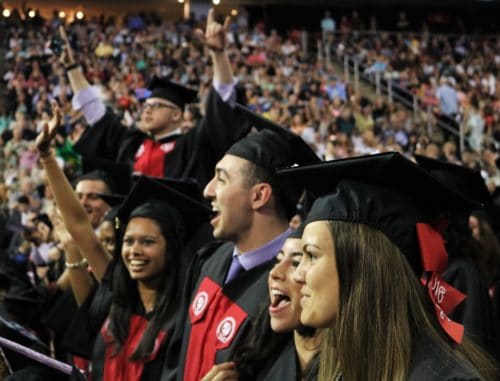
Earning an undergraduate degree in four years has become increasingly unrealistic.
Photo credit by Daniel Falkenheim
Benjamin Franklin once said in his essay “Advice to a Young Tradesman” that “time is money,” meaning time is a means of making money; it isn’t “idle.” However, across US colleges and universities, the famous maxim has evolved into its own literal meaning.
With graduation rates plummeting, extra semesters adding up and indecisiveness in choosing majors growing, the long-established notion of obtaining a four-year degree and graduating “on time” has prolonged itself into a five- or six-year graduation program.
The website TakePart published a recent study done by the national student clearinghouse showing that less than half of full-time college students earn their bachelor’s degree in four years. A smaller sample from a July 2014 to June 2015 study showed that four-year public college and university students in Virginia took an average of five years to complete their degrees. Private schools only achieved slightly better completion time of 4.8 years.
In 2013, Time Magazine illustrated the grim portrait of students taking five to six years or more to obtain their degrees, reporting a mere 40 percent graduating “on time” and the remaining 60 percent graduating within the six-year period.
In 2014, The New York Times reported that universities are developing a new six-year graduation benchmark for students working towards their Bachelor of Arts, and three years for their associate’s degree.
The explanation for lower four-year graduation rates can be found in numerous studies, along with their negative effects. Among them are rising tuition costs and the inability to pay them off. Some college students compensate school time by taking off semesters or becoming part-time students.
TakePart reported that students are often forced to enroll in unnecessary, no-credit remedial courses that add up to a hidden higher cost of $1.5 billion nationwide, and a 70 percent increase in debt for up to two years individually.
Another cause might be the overwhelming catalog of majors to choose from that often leads students to change majors midway and have to catch up. The most detrimental consequences are forfeiting students’ opportunity to make a career salary, rivaling tech-savvy international countries and dropping out completely.
Schools are affected as well. They could jeopardize their national graduation ranking, which is vital for recruiting prospective students, as well as overcrowd their classrooms, reported The New York Times.
In 2013, Purdue University launched their explanatory studies program, which gives students the opportunity to “[explore] courses across disciplines to [aid] students” in making better decisions in choosing their major and get a kick-start through extra “academic boot camps in the summer” before their freshman year.
Even so, while Purdue University has sustained a one-year retention rate of 91.8 percent, their four year graduation rate amounts to only 55.9 percent of students, and a six-year benchmark of 77.0 percent.
For these reasons, serious higher education reform is needed. We, as the Montclair State student body, should use our best judgment in electing government officials that will prioritize investing in lowering tuition costs, providing quality of education and regaining competitive advantage in the global market. Your voice and your vote truly matter. Only then can we transform the education system to its very core.


